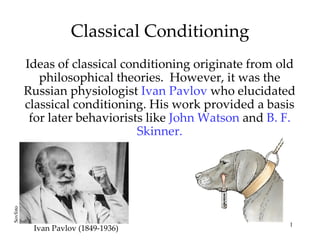
Classical Conditioning
- 1. Classical Conditioning Ideas of classical conditioning originate from old philosophical theories. However, it was the Russian physiologist Ivan Pavlov who elucidated classical conditioning. His work provided a basis for later behaviorists like John Watson and B. F. Skinner. Sovfoto 1 Ivan Pavlov (1849-1936)
- 2. Pavlov’s Experiments Before conditioning, food (Unconditioned Stimulus, US) produces salivation (Unconditioned Response, UR). However, the tone (neutral stimulus) does not. 2
- 3. Pavlov’s Experiments During conditioning, the neutral stimulus (tone) and the US (food) are paired, resulting in salivation (UR). After conditioning, the neutral stimulus (now Conditioned Stimulus, CS) elicits salivation (now Conditioned Response, CR) 3
- 4. Acquisition Acquisition is the initial stage in classical conditioning in which an association between a neutral stimulus and an unconditioned stimulus takes place. 1. In most cases, for conditioning to occur, the neutral stimulus needs to come before the unconditioned stimulus. 2. The time in between the two stimuli should be about half a second. 4
- 5. Acquisition The CS needs to come half a second before the US for acquisition to occur. 5
- 6. Extinction When the US (food) does not follow the CS (tone), CR (salivation) begins to decrease and eventually causes extinction. 6
- 7. Spontaneous Recovery After a rest period, an extinguished CR (salivation) spontaneously recovers, but if the CS (tone) persists alone, the CR becomes extinct again. 7
- 8. Stimulus Generalization Tendency to respond to stimuli similar to the CS is called generalization. Pavlov conditioned the dog’s salivation (CR) by using miniature vibrators (CS) on the thigh. When he subsequently stimulated other parts of the dog’s body, salivation dropped. 8
- 9. Stimulus Discrimination Discrimination is the learned ability to distinguish between a conditioned stimulus and other stimuli that do not signal an unconditioned stimulus. 9
- 10. Extending Pavlov’s Understanding Pavlov and Watson considered consciousness, or mind, unfit for the scientific study of psychology. However, they underestimated the importance of cognitive processes and biological constraints. 10
- 11. Cognitive Processes Early behaviorists believed that learned behaviors of various animals could be reduced to mindless mechanisms. However, later behaviorists suggested that animals learn the predictability of a stimulus, meaning they learn expectancy or awareness of a stimulus (Rescorla, 1988). 11
- 12. Biological Predispositions Pavlov and Watson believed that laws of learning were similar for all animals. Therefore, a pigeon and a person do not differ in their learning. However, behaviorists later suggested that learning is constrained by an animal’s biology. 12
- 13. Biological Predispositions Courtesy of John Garcia Garcia showed that the duration between the CS and the US may be long (hours), but yet result in conditioning. A biologically adaptive John Garcia CS (taste) led to conditioning and not to others (light or sound). 13
- 14. Biological Predispositions Even humans can develop classically to conditioned nausea. 14
- 15. Pavlov’s Legacy Pavlov’s greatest contribution to psychology is isolating elementary behaviors from more complex ones through objective scientific procedures. Ivan Pavlov (1849-1936) 15
- 16. Applications of Classical Conditioning Watson used classical conditioning procedures to develop advertising campaigns for a number of organizations, including Maxwell House, making the “coffee break” an American Brown Brothers custom. John B. Watson 16
- 17. Applications of Classical Conditioning 1. Alcoholics may be conditioned (aversively) by reversing their positive-associations with alcohol. 2. Through classical conditioning, a drug (plus its taste) that affects the immune response may cause the taste of the drug to invoke the immune response. 17
Hinweis der Redaktion
- OBJECTIVE 2 | Explain how an unconditioned stimulus (US)
- Unconditioned Stimulus (UCS): A stimulus that automatically and naturally triggers a response. Unconditioned Response (UCR): A unlearned, naturally occurring response to the unconditioned stimulus, like salivation in the dog when food is in the mouth. Conditioned Stimulus (CS): Originally a neutral stimulus that, after association with an unconditioned stimulus, comes to trigger a conditioned response. Conditioned Response (CR): A learned response to a previously neutral conditioned stimulus.
- OBJECTIVE 3 | Describe the timing requirements for the initial learning of a stimulus-response relationship.
- OBJECTIVE 4 | Summarize the processes of extinction, spontaneous recovery, generalization, and discrimination.
- OBJECTIVE 5 | Discuss the survival value of extinction, spontaneous recovery, generalization and discrimination.
- OBJECTIVE 6 | Discuss the importance of cognitive processes in classical conditioning.
- OBJECTIVE 7 | Describe some of the ways that biological predisposition can affect learning by classical conditioning.
- OBJECTIVE 8 | Summarize Pavlov’s contribution to our understanding of learning.
- OBJECTIVE 9 | Describe some uses of classical conditioning to improve human health and well-being.